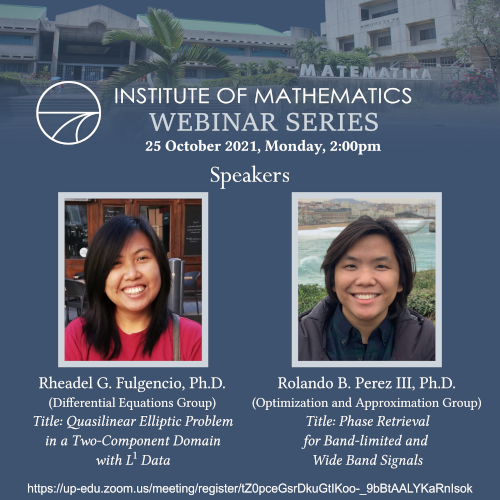IMath Webinar Series: Rheadel G. Fulgencio, Ph.D. and Rolando B. Perez III, Ph.D.

You are all invited to attend the third webinar of the IMath Webinar Series on Monday, October 25, 2021, 2pm. Dr. Fulgencio and Dr. Perez will be our speakers.
Rheadel G. Fulgencio, Ph.D. (Differential Equations Group)
Title: Quasilinear Elliptic Problem in a Two-Component Domain with \(L^1\) Data
Abstract: The framework of renormalized solution, which was first introduced by R.J. DiPerna and P.L. Lions, is one of the frameworks used to obtain existence, uniqueness, and stability results for problems with weak data (e.g., \(L^1\) data, not globally bounded matrix field). In this talk, we consider an elliptic problem posed in a two-component domain, where the given function belongs to \(L^1\). We first introduce a definition of a renormalized solution adapted to our problem. Due to the nature of the domain, this definition has some additional conditions compared to the standard in the renormalized framework. We then present a sketch of the proof of the existence of a renormalized solution to our problem.
Rolando B. Perez III, Ph.D. (Optimization and Approximation Group)
Title: Phase Retrieval for Band-limited and Wide Band Signals
Abstract: The study of phase retrieval involves the recovery of a function \(f\) in some function space from given data about the magnitude \(|f|\) and other assumptions on \(f\), where these other assumptions can be in terms of some transform of \(f\). Phase retrieval problems are widely studied because of their physical applications in fields of science and engineering. In this talk, we first solve the classical phase retrieval problem for band-limited signals, which are functions with compactly-supported Fourier transforms. Next, we solve the phase retrieval problem for wide band signals, which are functions with mildly decreasing Fourier transforms. To obtain all solutions of these problems, we shift to the complex analytic scenario via Paley-Wiener theorems and take advantage of certain factorization properties. Finally, we consider these problems coupled with additional magnitude constraints, and determine if these constraints force uniqueness of the solution.
